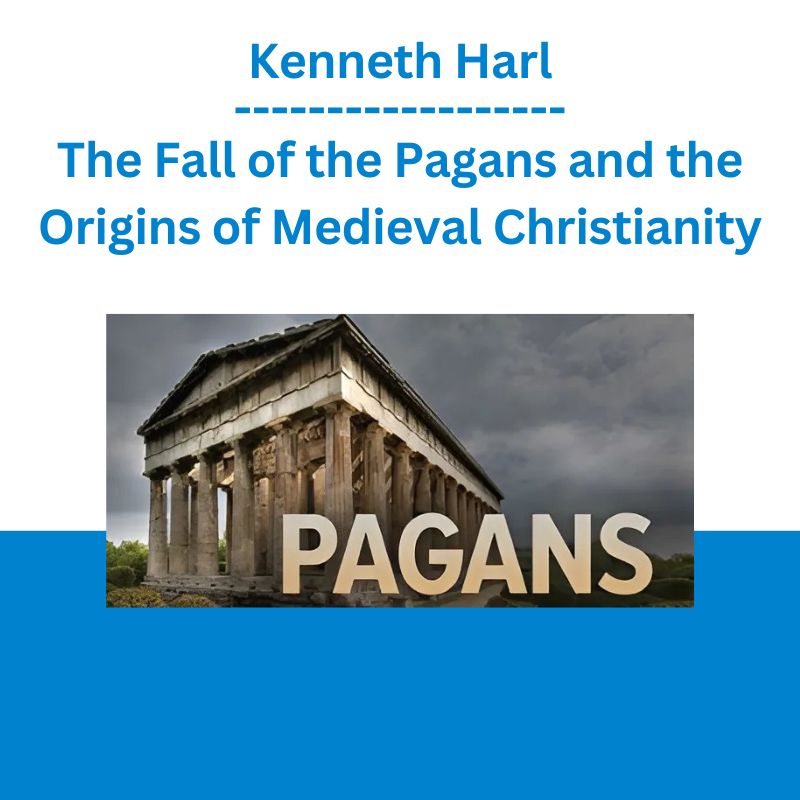*** Proof of Product ***
Exploring the Essential Features of “Kenneth Harl – The Fall of the Pagans and the Origins of Medieval Christianity”
The Fall of the Pagans and the Origins of Medieval Christianity
Join a historically focused discussion of the dramatic interaction between Judaism, Christianity, and paganism presented by an award-winning teacher, classical scholar, and one of the most esteemed historians at The Great Courses.
LECTURE (24)
01:Religious Conflict in the Roman World
The Christianization of the Roman world is one of the most important turning points in Western civilization. This lecture introduces you to the issues you will consider and the scholars whose seminal theories serve as the gateways to the course’s different lines of exploration….
02:Gods and Their Cities in the Roman Empire
How were pagan gods worshiped in ancient Rome? Using evidence both literary and archaeological, grasp the diverse assortment of religious practices in an empire that ranged from Britain to Egypt and comprised a fifth of the world’s population….
03:The Roman Imperial Cult
Learn how Rome’s first emperor, Augustus, established an institution to venerate an emperor’s spirit, or genius, which would then reside as a god on Mount Olympus. See how emperors took pains to deify their predecessors so as to position themselves next among that honored line….
04:The Mystery Cults
Mystery cults were believed to be the worship to a particular god and involved the choice to join and undergo an initiation rite. You examine specific cults and the controversial question of whether they did, in fact, form a bridge between paganism and Christianity, as some scholars maintain….
05:Platonism and Stoicism
Understand the powerful influence of philosophy-particular Platonism and Stoicism-on the morality and conduct of Rome’s ruling classes. It was an influence rarely matched in the Western tradition, with even Christian theologians employing the doctrines of these two philosophical schools in defining their own faith….
06:Jews in the Roman Empire
What role did Judaism play in the Roman Empire? Learn how Rome’s experience with this stalwart monotheistic faith-the first it had encountered-differed from the challenge of the Christian faith that would emerge from it….
07:Christian Challenge-First Conversions
Experience the first years of efforts to convert people to Christianity. Begin with the early leadership by James of those who were often called Jewish Christians and continue with the career of Paul, from his own conversion after a vision to his work propagating the message of Jesus….
08:Pagan Response-First Persecutions
Learn about early responses to Christianity, from the violent persecutions in Rome under Nero to the legalistic and easily avoided persecutions under later emperors. Grasp, too, the consequences of Roman ignorance of Christianity and the eventual momentum that ignorance would eventually give the new faith….
09:Christian Bishops and Apostolic Churches
Nero’s outlawing of a specific religion-unprecedented in Roman history-forced Christians to discover new ways to proselytize. Discover how the ideas of apostolic succession and a recognized canon shaped the voice with which Christianity could speak to the world….
10:Pagan Critics and Christian Apologists
Explore how both Christianity’s pagan critics and its apologists reveals not only an evolution in pagan understanding of the new faith but a corresponding increase in the sophistication of the writings set forth by those defending it….
11:First Christian Theologians
Examine the work of Saint Clement, who established Christianity’s claim to equality with the pagans as heirs to classical intellectual culture, and of Origen, whose ability to argue in Platonic terms and contributions to defining the canon make him one of the most important thinkers in Christian history….
12:Imperial Crisis and Spiritual Crisis
The stability and peace of the Roman Empire was shattered with the assassination of Severus Alexander, and the ensuing political and military crisis transformed the Roman world. Many have maintained that this crisis paved the way for large-scale Christian conversion, but there are tantalizing arguments to the contrary….
13:The Great Persecutions
Analyze two great periods of empire-wide persecution distinct from the largely localized ones examined earlier. Learn how Christian martyrdom was perceived very differently by the pagan and Christian communities, and that its ability to bring about conversions may have been minimal….
14:The Spirit of Late Paganism
Explore how the spiritual life of paganism fared during the political and military crises examined in the preceding lectures. See how these had an impact on not only pagan worship but also the intellectual work of pagan philosophers like Plotinus and the emergence of an independent religion known as Manichaeism….
15:Imperial Recovery under the Tetrarchs
The 20-year period known as the Tetrarchy-during which the emperor Diocletian shared imperial power with three colleagues–was critical to the Roman Empire, ending civil war and invasion, restoring order and prosperity, and giving Rome something it had never had: a principle of succession….
16:The Conversion of Constantine
Analyze one of the most decisive turning points in Roman history and of Western civilization. Interpret the legendary story as it has come down to us in light of recent scholarship and what we now understand about Constantine’s world and the forces that would have motivated him….
17:Constantine and the Bishops
See how the same principle that had always steered Rome’s efficient use of power-absorbing institutions rather than simply crushing them-was used to create a new hierarchy within the Roman imperial system from the existing network of apostolic churches….
18:Christianizing the Roman World
How and why did Constantine set about making the Christian faith central to Roman life? See how his vision unfolded in multiple areas, including the reshaping of the urban landscape to claim public and religious space, economic changes, and the use of pilgrimages and Christian missionary activity….
19:The Birth of Christian Aesthetics and Letters
Explore how Christians managed to alter the cultural heritage of their pagan past-including architecture and the visual and literary arts-in ways that made this heritage distinctly Christian while still preserving as much of it as possible….
20:The Emperor Julian and the Pagan Reaction
Experience what happened when a Christianizing Roman world was told by their new emperor that decades of change would be undone and that Rome’s religious and cultural history would again be reversed, this time turning back to paganism and a restoration of the old gods….
21:Struggle over Faith and Culture
Grasp how the death of Julian the Apostate-and the end of his short-lived program to restore paganism’s dominant role-forced the empire to grapple with two all-encompassing questions: Could the Constantinian revolution in fact be reversed? What religion would take charge in the Roman world?…
22:New Christian Warriors-Ascetics and Monks
Take in the different perceptions of asceticism by pagans and Christians and how Christian ascetics and monks, in particular, proselytized and won conversions to Christianity with a power and influence that even the Roman Empire could not have matched….
23:Turning Point-Theodosius I
Witness the crucial turning point in the spread of Christianity in the Roman world. Three new laws opened the floodgates for the destruction of pagan sanctuaries, a ban on public sacrifices, and the declaration of Nicene Christianity as the only legitimate faith and a requirement for citizenship….
24:Justinian and the Demise of Paganism
Learn how Justinian, even in a Roman world still predominantly pagan, implemented a “persecuting society” that would ensure, by the time of his death, a Western world where being civilized was defined as being Christian, as were its notions of the divine and the ethical….
DETAILS
Overview
Why did pagan Rome clash with early Christians? How did Christianity ultimately achieve dominance in the Roman Empire and eclipse paganism in one of the most influential turning points in the history of the West? Find out the startling answers to these and other questions with The Fall of the Pagans and the Origins of Medieval Christianity. This historically focused discussion of the dramatic interaction between Judaism, Christianity, and paganism from the 1st to the 6th centuries-delivered by classical scholar and award-winning Professor Kenneth W. Harl-allows you to explore in great depth the reasons that Christianity emerged and sparked a major transition for religion, culture, and politics.
About
Kenneth W. Harl
“We will be looking largely at archeological evidence and analysis done by anthropologists because we are operating largely in a world without writing.”
ALMA MATER Yale University
INSTITUTION Tulane University
Dr. Kenneth W. Harl is Professor of Classical and Byzantine History at Tulane University in New Orleans, where he teaches courses in Greek, Roman, Byzantine, and Crusader history. He earned his B.A. from Trinity College and his M.A. and Ph.D. from Yale University. Recognized as an outstanding lecturer, Professor Harl has received numerous teaching awards at Tulane, including the coveted Sheldon H. Hackney Award. He has earned Tulane’s annual Student Body Award for Excellence in Teaching nine times and is the recipient of Baylor University’s nationwide Robert Foster Cherry Award for Great Teachers. In 2007, he was the Lewis P. Jones Visiting Professor in History at Wofford College. An expert on classical Anatolia, he has taken students with him into the field on excursions and to assist in excavations of Hellenistic and Roman sites in Turkey. Professor Harl has also published a wide variety of articles and books, including his current work on coins unearthed in an excavation of Gordion, Turkey, and a new book on Rome and her Iranian foes. A fellow and trustee of the American Numismatic Society, Professor Harl is well known for his studies of ancient coinage. He is the author of Civic Coins and Civic Politics in the Roman East, A.D. 180-275 and Coinage in the Roman Economy, 300 B.C. to A.D. 700.
Please see the full list of alternative group-buy courses available here: https://lunacourse.com/shop/










 Erik Banks - Alternative Risk Transfer
Erik Banks - Alternative Risk Transfer